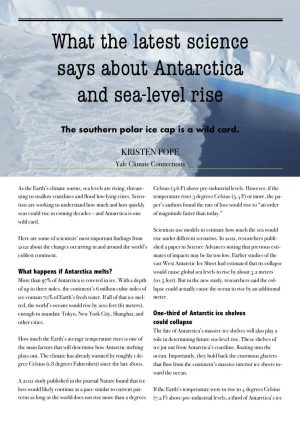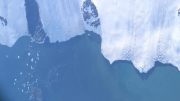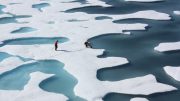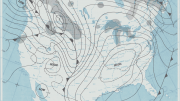 As the Earth’s climate warms, sea levels are rising, threatening to swallow coastlines and flood low-lying cities. Scientists are working to understand how much and how quickly seas could rise in coming decades – and Antarctica is one wild card.
As the Earth’s climate warms, sea levels are rising, threatening to swallow coastlines and flood low-lying cities. Scientists are working to understand how much and how quickly seas could rise in coming decades – and Antarctica is one wild card.
Here are some of scientists’ most important findings from 2021 about the changes occurring in and around the world’s coldest continent.
What happens if Antarctica melts?
More than 97% of Antarctica is covered in ice. With a depth of up to three miles, the continent’s 6 million cubic miles of ice contain 70% of Earth’s fresh water. If all of that ice melted, the world’s oceans would rise by 200 feet (61 meters), enough to inundate Tokyo, New York City, Shanghai, and other cities.
How much the Earth’s average temperature rises is one of the main factors that will determine how Antarctic melting plays out. The climate has already warmed by roughly 1 degree Celsius (1.8 degrees Fahrenheit) since the late 1800s.
A 2021 study published in the journal Nature found that ice loss would likely continue at a pace similar to current patterns as long as the world does not rise more than 2 degrees Celsius (3.6 F) above pre-industrial levels.
However, if the temperature rises 3 degrees Celsius (5.4 F) or more, the paper’s authors found the rate of loss would rise to “an order of magnitude faster than today.”
Scientists use models to estimate how much the sea would rise under different scenarios. In 2021, researchers published a paper in Science Advances noting that previous estimates of impacts may be far too low. Earlier studies of the vast West Antarctic Ice Sheet had estimated that its collapse would cause global sea levels to rise by about 3.2 meters (10.5 feet). But in the new study, researchers said the collapse could actually cause the ocean to rise by an additional meter.
One-third of Antarctic ice shelves could collapse
The fate of Antarctica’s massive ice shelves will also play a role in determining future sea-level rise. These shelves of ice jut out from Antarctica’s coastline, floating into the ocean. Importantly, they hold back the enormous glaciers that flow from the continent’s massive interior ice sheets toward the ocean.
If the Earth’s temperature were to rise to 4 degrees Celsius (7.2 F) above pre-industrial levels, a third of Antarctica’s ice shelves could become destabilized and would be at risk of collapse, according to an April 2021 paper in Geophysical Research Letters. About 193,000 square miles (500,000 square kilometers) of these ice shelves — an area slightly smaller than California and South Carolina combined — could fail. The effect of ice shelf collapse, the researchers said, would be akin to pulling a cork out of a large bottle, speeding the movement of ice into the ocean.
Some ice shelves are already melting rapidly. The George VI Ice Shelf is the second-largest ice shelf on the Antarctic Peninsula, the northernmost region of mainland Antarctica. Scientists reported that 2019-2020 was a record-breaking melt year, with “the most widespread melt” they’d seen there, though they did note they had seen longer melting seasons for the peninsula as a whole before.
Thwaites: the ‘Doomsday Glacier‘
Perhaps the most talked-about Antarctic ice story of 2021 was the potential fate of Thwaites Glacier, popularly dubbed the “Doomsday Glacier.” This massive body of ice, larger than the state of Florida, is located on the West Antarctic Ice Sheet.
In December 2021, scientists announced that cracks in the Thwaites Eastern Ice Shelf signaled that this ice shelf — which is holding back large parts of the Thwaites Glacier — could fail in as soon as five years. Without the ice shelf to stabilize it, the glacier could speed up its flow into the ocean. If the entire glacier melted, sea levels around the world would eventually rise about 25 inches (63.5 centimeters).
Pine Island Glacier thins, Getz region loses ice
Pine Island Glacier, which contains 180 trillion tons of ice, has been thinning for decades. And between the 1990s to 2009, the glacier’s flow toward the ocean accelerated from around 1.5 miles (2.4 kilometers) per year to approximately 2.5 miles (4 km) per year, staying toward the higher end of that range for around a decade. And its movement continues to speed up: Researchers published a 2021 paper in Science Advances showing that from 2017 to 2020, the rate of flow increased by around 12%.
The Getz region in West Antarctica is also showing signs of speeding up. One study published in Nature Communications found that most glaciers in the region were accelerating. Between 1994 and 2018, the glaciers in this region lost about 315 metric gigatons of ice.
Parker Ice Tongue collapsed in 2020
Ice tongues are distinctive features that protrude from a glacier and can stick out far into the ocean. Normally, sea ice that is attached to land helps stabilize them and protect them from the ocean’s waves and currents. However, when sea ice disappears, the ice tongues are more vulnerable to collapse.
In March 2020, the nearly 16-square-mile (41-square-kilometer) Parker Ice Tongue fully collapsed into the western Ross Sea. In December 2021, scientists published a paper in Geophysical Research Letters detailing their findings about the event. While the authors believe that calving likely occurred on and off for many centuries in the region, this loss was massive – and unusual. The authors wrote, “A complete ice tongue collapse for these otherwise stable glaciological landmarks along the Victoria Land Coast is previously unrecorded.”
It could rain more often in Antarctica
Antarctica isn’t known for rainy days. The continent’s high plateau very (very!) rarely gets rain. The northwestern Antarctica peninsula is the continent’s rainiest region, with around 50 days of rain each year.
But a 2021 study in Geophysical Research Letters found the continent’s rainfall could increase 240% by the turn of the century. The researchers also forecast more intense storms.
Liquid precipitation could cause big problems and lead to faster ice melt, especially as the insulating snow on top of the ice melts, making the ice more vulnerable.
Rain also is a threat to wildlife like penguins. Young penguin chicks are coated with downy feathers that are not rainproof. Wet chicks can freeze, especially in stormy and windy weather.
And rain is already causing problems for penguin colonies. During the 2013-2014 season, one Adélie penguin colony with about 20,000 breeding pairs failed to produce a single surviving chick. Scientists believe rain was one of the factors involved.
Melting ice in Antarctica could cause ecosystem-wide effects
Melting ice also changes the composition of the ocean itself. To study how the water is changing, scientists affixed data loggers to 14 seals near Pine Island Glacier, using the seals — and other methods — to gather data, including water temperature and salinity. Their results, published in Communications: Earth and Environment, suggest that when warmer meltwater rises to the top of the ocean, it can make it harder for sea ice to form, causing areas of open water. Warmer water on the surface can also lead to other ecosystem impacts.
As scientists continue to study Antarctic ice, we will learn more about how this “wild card” may affect life, not only on the Seventh Continent, but all around the world.
This article was originally published on Yale Climate Connections under the Creative Commons licence.





